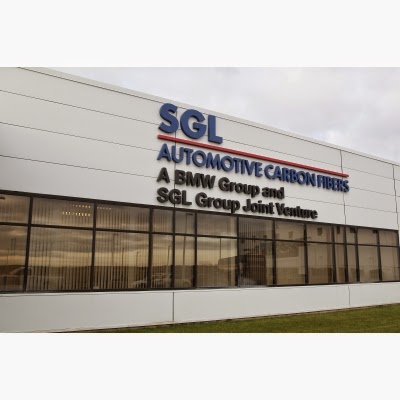BMW may be joining the ranks of automakers giving serious support to the electric vehicle cause. Those companies are currently Nissan/Renault and Tesla Motors, both of whom have a strong EV sales record and are working to develop electric vehicle charging infrastructure. GM is almost a serious electric vehicle maker, with the Chevy Volt, but they keep dissing electric cars so I leave them off the list. BMW started delivering the BMW i3 last fall in Europe and last month in the U.S., is due to start BMW i8 deliveries real soon now, appears to be producing the BMW i3 at a respectable rate, 100 i3’s a day, and is expected to add more vehicles to the BMW i series.
Today, BMW announced an increased production rate in the carbon fibre material used in building the BMW i3 and i8. This is a concrete demonstration of serious intent on BMW’s part.
One of the way-cool factors of the BMW i3 and i8 is having
developed the first volume production process for carbon fibre, in
order to save weight to make the best use of the stored energy in the
battery pack. A lower weight car requires less energy for motion, and carbon fibre has extremely low weight, extremely high strength, for an extremely attractive power to
weight ratio. Carbon fibre has long been reserved to high end vehicles
like jet airplanes, rocket ships, and race cars. It wasn’t suitable for
mass production cars because of extremely high cost. Until the BMW i3.
To do this BMW formed a partnership with the SGL Group, and together the companies built a factory in Moses Lake Washington. SGL takes raw material manufactured in Japan, ships it to Washington where there’s a massive amount of low cost renewable electricity thanks to Washington’s hydroelectric capacity. SGL then ships the material to BMW’s factories in Germany, where BMW uses the fibres to make automotive parts.
Today’s announcement is that SGL and BMW are tripling the production capacity of the Moses Lake facility. This is an additional investment of $200 million, that will increase production capacity to 9000 tons of carbon fibre a year. That will make the Moses Lake facility the world’s largest carbon fibre plant, and it will employ 200 people.
Current output from Moses Lake is 3,000 tons a year on two production lines. This summer they’ll finalize a 3rd and 4th production line increasing capacity to 6,000 tons a year. A fifth and sixth line will be added by 2015, increasing the capacity to 9,000 tons a year.
The carbon fibres made by SGL at Moses Lake are manufactured into carbon-fibre-reinforced-plastic components by BMW in their factories in Germany. Initially, BMW is using this material in the BMW i series cars, but will expand its use to other automobile lines over time. BMW has used the expensive form of carbon fibre in the BMW M series for about 10 years.
Carbon fibre production requires prodigious amounts of electricity. The companies chose Moses Lake because of hydroelectric capacity, giving them a reliable source of inexpensive electricity that oh-by-the-way they can claim is renewable energy as well.
- Highway design could decrease death and injury risk, if “we” chose smarter designs - March 28, 2015
- GM really did trademark “range anxiety”, only later to abandon that mark - March 25, 2015
- US Government releases new regulations on hydraulic fracturing, that some call “toothless” - March 20, 2015
- Tesla Motors magic pill to solve range anxiety doesn’t quite instill range confidence - March 19, 2015
- Update on Galena IL oil train – 21 cars involved, which were the supposedly safer CP1232 design - March 7, 2015
- Another oil bomb train – why are they shipping crude oil by train? – Symptoms of fossil fuel addiction - March 6, 2015
- Chevron relinquishes fracking in Romania, as part of broader pull-out from Eastern European fracking operations - February 22, 2015
- Answer anti- electric car articles with truth and pride – truth outshines all distortions - February 19, 2015
- Apple taking big risk on developing a car? Please, Apple, don’t go there! - February 16, 2015
- Toyota, Nissan, Honda working on Japanese fuel cell infrastructure for Japanese government - February 12, 2015




















